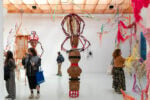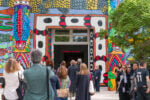Shannon Bool – Don’t know what you’ve got till it’s gone
.jpg)
Pavillon social Kunstverein è lieta di annunciare la mostra personale dell’artista canadese Shannon Bool.
Comunicato stampa
Pressrelease - ita
Pavillon social Kunstverein ~ Lucca
SHANNON BOOL
Don't know what you’ve got till it's gone
“Hi, just back ... I was thinking of the title: "Don't know what you've got 'till it's gone" as the phrase jumped into my head when I was making the works. Both the carpets and photograms illuminate information through formal subtractions (cutting out Maria, cutting out Paris exhibition figures) and replacements, the beauty of absence... It is a quote from a Joni Mitchell song from the seventies (Big Yellow Taxi); you pave paradise and put up a parking lot.”
Pavillon social Kunstverein è lieta di annunciare la mostra personale dell’artista canadese Shannon Bool, sabato 27 settembre alle ore 18:00.
Nel momento in cui l’occidente colonizza l’oriente, cristallizzando un’idea di se stesso tra otto e nove- cento, è allora che inizia a immaginare il levante come diverso; per poi però adottarne la suggestione come evasione dal raziocinio (anche attraverso le droghe: l’oppio e l’hashish), dalla storia progressiva (verso eclettici revival), dall’oppressione dell’abbigliamento, da religioni repressive e infine dalle costrizioni sessuali - immaginando harem, costumi disinibiti esotici ed erotici. La sessualità cacciata dalla porta d’ingresso; ovvero la doppia morale, borghese e vittoriana, lascia che sia proprio l’erotismo a rientrare dalle finestre. Ci si riferisce al tempo di Freud e della scoperta dell’inconscio, quando nel suo studio ricoperto di tappeti orientali, da una scrivania affollata di divinità egizie e pagane, il padre della psicanalisi oppone il baluardo materialista della teoria sessuale a fronte del proliferare dei simboli e del neo-spiritualismo dilagante.
Se il progresso della cultura occidentale sembra dover coincidere con la rimozione dell’ornamento da ogni utensile, da un lato ecco Adolf Loos, con l’ornamento come delitto, e poi da un altro Ludwig Wittgenstein, tra la progettazione della casa di sua sorella a Vienna e la riformulazione della logica, del suo Tractatus che sembra una tabula rasa, pur provvisoria, alla ricerca di punti fermi.
Eppure, dal lato artistico, ecco allora che la nascita della modernità tra otto e novecento si associa all’eclettismo storicista e orientalista, allo stile floreale, la riscoperta dell’art nègre, poi all’art deco. E’ così che torna l’arabesco quale contrappasso barocco alla linearità razionale. Si direbbe che la nascita di un paradigma culturale moderno e occidentale cresca sulle spalle di ciò che nel medesimo tempo reprime: il fascino della natura, della libera crescita dei fiori, delle piante, e dei corpi liberi dalle costrizioni culturali come nella danza di Isadora Duncan, i vestiti di Mariano Fortuny o Paul Poiret, il vegetarianesimo, la scoperta delle culture orientali... Shannon Bool sembra ripercorrere questo continuo paradosso tra repressione e ritorno del represso. In una modalità quasi narrativa in Harem inverted, dove esili colonne di metallo, che pur richiamano suggestioni sumere di De Dominicis, diventano allusioni erotiche e pali da lapdance, e ancora un excursus da esibizioni notturne in night club via fino ai centri fitness.
L’attenzione al dettaglio, per una modalità forse più descrittiva invece quando a Firenze recentemente ha filmato un tappeto orientale, un gigantesco tappeto mammelucco del Cinquecento, riscoperto solo negli anni ottanta del secolo scorso nei sotterranei di Palazzo Pitti (Forensics for a Mamluk, 2013) e avviene che d’improvviso si disvela qualcosa che era stato dimenticato, trascurato, non visto, rimosso: il tappeto, un fondo, una semplice decorazione, una sorta di scenario geometrico. Come nella Madonna di Lucca di Jan van Eyck dove tra le pareti così intime della stanza figurava un tappeto anatolico pur messo in prospettiva, ma che non era ancora inteso come si direbbe oggi ‘occidentale’. Si mette in scena il disvelamento del rimosso, l’affiorare del represso, del dimenticato, dell’inosservato. Diventa visibile ciò che è visibile è sempre stato, ma a cui mancava l’evidenza, la coscienza, figlia del cambia- mento e della cesura
Shannon Bool, nata a Comox, in Canada, studia all’Emily Carr Institute of Art and Design di Vancouver, al Cooper Union di New York e infine alla Städelschule di Francoforte sul Meno. Nel 2013 è tra i vincitori del Premio Villa Romana a Firenze. Il suo lavoro è stato esposto in musei e istituzioni internazionali tra cui la Gesellschaft fur Aktuelle Kunst di Brema (2010) e la Bonner Kunstverein (2011). Il suo lavoro è diventato parte delle collezioni del Museum fur Moderne Kunst di Francoforte sul Meno, del Lenbachhaus, di Monaco, ma anche di numerose collezioni private, fino a includere la Saatchi Collection di Londra. Il suo lavoro figura in numerose collettive, fra cui recentemente Screen and Décor, a cura di Rosemary Heather, al Southern Alberta Art Gallery; Soft Pictures, a cura di Irene Calderoni alla Fondazione Sandretto Re Rebaudengo di Torino; Girls Can Tell, al Gesellschaft für Aktuelle Kunst di Brema. L’artista vive e lavora a Berlino.
Pressrelease - eng
Pavillon social Kunstverein ~ Lucca
SHANNON BOOL
Don't know what you’ve got till it's gone
“Hi, just back ... I was thinking of the title: "Don't know what you've got 'till it's gone" as the phrase jumped into my head when I was making the works. Both the carpets and photograms illuminate information through formal subtractions (cutting out Maria, cutting out Paris exhibition figures) and replacements, the beauty of absence... It is a quote from a Joni Mitchell song from the seventies (Big Yellow Taxi); you pave paradise and put up a parking lot.”
Pavillon social Kunstverein is pleased to announce the solo exhibition of the Canadian artist Shannon Bool, opening Saturday the 27th of September at 6.00 pm.
Since the West colonized the East, between the eighteenth and the nineteenth centuries, the West began to imagine the East as something different as it began questioning the idea of “itself”. Western life became influenced by the East, at least through escaping from its own rational thought (i.e. through drugs, like opium and hashish), or through finding an alternative to the linear construction of history. These tendencies were seen in revivals in eclecticism that meant to elude oppression expressed through fashion, or in shunning repressive religions and eventually sexual compulsions. East is seen as a harem environment: with exotic, erotic, and uninhibited customs.
Sexuality is chased away, as they say, from the main door. Both main moralities, that of the civilian’s and that of the Victorian’s, let Eros return through the back door. This is the age when Freud discovers the unconscious: in his theory based on sexuality, the father of psychoanalysis strongly opposed the proliferation of symbols and neo-spiritualism as his specific materialist bulwark. Notably, his office was strewn with oriental rugs; his shelves and desk were crowded with numerous anthropological artifacts, including so called “primitive”, Egyptian and Pagan deities.
At the birth of modernism, Western culture seems to reach the point in which it surrenders ornament from any object. On one hand, we find Adolf Loos, with his own belief of “ornament as a crime”, on the other hand Ludwig Wittgenstein, in particular with our attention to the house he designed for his sister in Vienna, and his re-inventing of the logic in the “Tractatus”, that looks like a sort of philosophical “tabula rasa”, even if temporary, or an argumentation looking time and again for reference points.Nevertheless, between the Eighteenth and the Nineteenth Centuries the emergence of the Modern is connected with an historical and an eastern eclecticism. Parallel to modernism a new decorative style emerges, a new discovery of the art nègre, along with art déco... Additionally, there is always a revival of the arabesque, according to that Freudian rhetoric as something baroque twisting again logic, and to other theorists, such as Asger Jörn, who wrote that the arabesque is intrinsic to humanity and therefore would always triumph over functionalism.
Hence it looks like that the birth of a modern and a western cultural paradigm sponge on what it factually contemporary represses: the fascination of Nature, the freedom of the growing flowers and plants, the bodies that are far from cultural compulsions like the dance of Isadora Duncan, the clothes for example those designed by Mariano Fortuny or Paul Poiret, and then the practice of vegetarianism and the discovery of eastern arts.
Shannon Bool seems to trace and follow this continuous paradox between repression and the re-emergence of what has been hidden. For example, in a story-tale manner, in the exhibition series Inverted Harem, she created sculptures of narrow metal columns that-also recalled the opera of De Dominicis with his Sumerian attitude, and alluded erotically to lap dance poles, and nocturnal excursions into night clubs and pole dancing fitness centers.
Bool’s focus on details and the description of details is palpable when she recently filmed an oriental carpet in Florence. It is the huge Medici Mamluk of the sixteenth century, which was rediscovered in the storage of the “Palazzo Pitti” in 1983 (Forensics for a Mamluk, 2013). Suddenly something forgotten, neglected, unseen, and removed is revealed; the carpet as a base, a simple decoration, a geometrical set of patterns that point us to the mysterious role the “East” played in the renaissance. In Jan Van Eyck’s Madonna di Lucca, among the intimate walls of the room portrayed in the painting, an Oriental carpet is placed in perspective (not meaning what we today call “western” perspective). The first carpet that Bool created using Anatolian weavers references the exchange of perspective in Madonna di Lucca, and fleshes out the experience of entering this perspective from both sides. The scene represented is a revelation of what is removed, the emerging of what has been repressed and forgotten, amnesia, or indolence, or negligence. In cinema this is called “eclipse”. Finally, as a result of these changes, the visible that has been hidden by a lack of the consciousness, appears.
Shannon Bool was born in Comox, in Canada. She studied at the Emily Carr Institute of Art and Design of Vancouver, at the Cooper Union of New York and more recently at Städelschule of Frankfurt am Main. In the 2013 she won the “Premio Villa Romana“ in Florence. Her work has been shown internationally in museums and institutions: among some we remember the Gesellschaft fur Aktuelle Kunst, Bremen and the Bonner Kunstverein (in 2010 and 2011 respectively). Bool’s’s work has became part of the collections of the Museum für Moderne Kunst of Frankfurt am Main, and of the museum of the Lenbachhaus, in Munich, plus several other private collections including the Saatchi Collection of London. Recently, her work has been appeared in several group exhibitions, including, Screen and Décor, by Rosemary Heather, at the Southern Alberta Art Gallery; Soft Pictures, by Irene Calderoni at Fondazione Sandretto Re Rebaudengo in Torino; and the Klontal Triennale, in Kunsthaus Glarus in Switzerland. Bool currently lives and works in Berlin.



